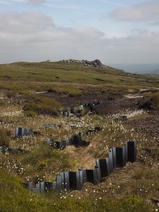Building Bogs
Some of the highpoints include the airlifting and spreading of 391 bags of chopped heather cuttings onto bare peat, the spreading of lime, seed and fertiliser via helicopter across 139 hectares, the installation of 1135 gully blocks (or dams), and the planting of sphagnum onto 144 hectares of moorland.
All of our conservation methods are designed to work together to help return the moors to healthy, active blanket bog. Without the lime, seed and fertiliser, the land may be too acidic and bare for bog plants to establish. Without the gully blocks raising the water table, the sphagnum moss would not thrive. And without the sphagnum moss the land would not be a carbon store.
Championing biodiversity
Further highlights include the clearing of 93 hectares of the non-native plant rhododendron, which will go a long way to reducing this plant’s ability to choke any environment where it takes root.
Bracken control took place across 14 hectares of moorland. Unlike rhododendron, bracken is a native species but its tendency to take over and suffocate other plant life means it needs to be controlled so that biodiversity can recover.
Cottoning onto sphagnum growth
The cutting count includes 16 hectares of molinia cutting, 5 hectares of heather cutting, and 1 hectare of cotton grass cutting. The differing vegetation is cut for a variety of reasons.
Cutting heather supplies us with heather brash, whilst also creating firebreaks in the case of wildfire. Molinia cutting reduces the dominating molinia, and helps other species to grow much like with bracken. And cotton grass cutting can help provide a breathing space for sphagnum moss to grow.
